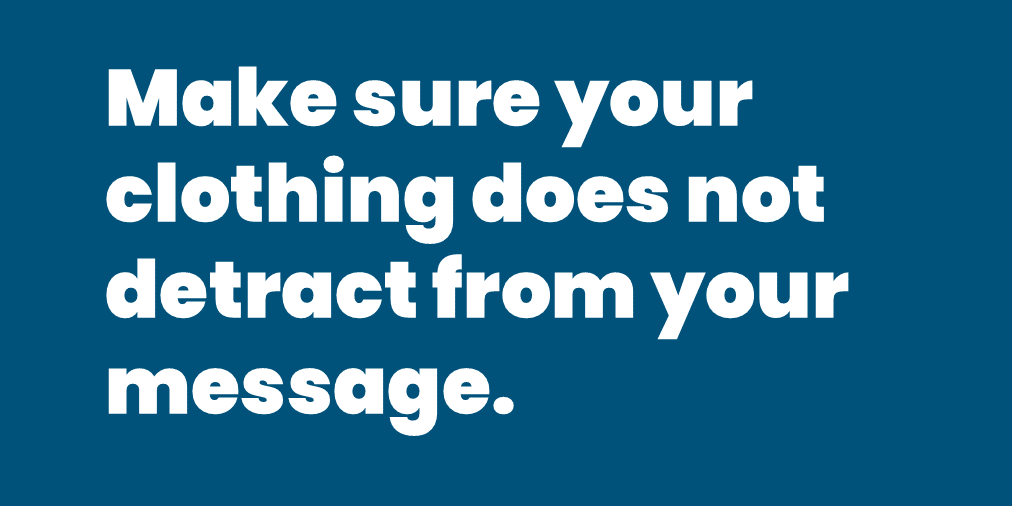
What to wear on TV? Make choices you won’t regret
“Do I really need to wear a tie on CNBC?”
Yes! Well, it depends.
“Can I wear my favorite neon-colored shirt?”
No! Really not a good idea.
“Do I need to wear pants?”
Not answering that.
Over the years we’ve provided numerous tips to portfolio managers and strategists fortunate enough to be interviewed on TV. Truthfully, since the pandemic, the need to be physically present in a studio has virtually disappeared with many interviews now conducted via computer. While most hosts have returned to their studios, many guests continue to conduct their interviews from the comfort of their offices.
Although standards regarding appropriate attire for your broadcast interview can greatly vary, our most crucial piece of advice is to ensure that your clothing does not detract from your message. Regrettably, due to television’s visual nature, loud colors, ill-fitting clothes, noisy jewelry and unkempt hair can cause viewers to think more about your appearance than your insights.
How to avoid becoming a meme
For men, an open-collared shirt in a neutral color, worn in a professional style, is acceptable. While it may seem outdated, we generally advise professionals to wear a tie and a jacket. In my opinion, there are certain occasions when donning more formal attire is appropriate—at a wedding, at the White House or during a TV interview. It might be different for tech executives or athletes, but most finance leaders managing other people’s money need to look the part.
For women there are a wider range of options, but we also recommend professional attire—a well-tailored suit or dress in neutral colors complemented with discreet jewelry. Avoid accessories like bangles that can be noisy. A dress or skirt that is too short may be uncomfortable for a seated interview.
For men or women, avoid all-black or all-white outfits as they can appear stark and cause problems with the cameras’ light exposure. Make sure your chosen fabric doesn’t make noise when you move. Also be careful with patterns. Thin stripes or houndstooth patterns can cause visual optical effects.
Despite remote guests believing that only their upper body will be on display, we strongly recommend you consider your entire outfit. No one wants to become a viral social media meme due to an unexpected camera angle revealing an inappropriate garment.
A note for in-studio guests: While awaiting your interview, a staff member is likely to prepare you by attaching a microphone to your chest and threading a wire through your clothes to a battery pack that will be clipped to your belt or waistband. Be ready for some slight manhandling. This process can pose a challenge for women wearing a dress or an outfit without a waistband, so keep this in mind when selecting your outfit.
Hair and make-up
Most studios apply light make up to both men and women due to the fact that bright lights can make most people appear washed out. This holds true for remote interviews as well. We’ve previously discussed how to put your best foot forward during remote interviews which includes investing in proper lighting. Many women we’ve worked with apply slightly more makeup than usual for interviews. Men might also consider adding some extra color or a light powder.
Regarding hair, while it isn’t necessary to schedule a stylist appointment or plan an elaborate hairstyle for your interview, ensure your hair is in place by checking in the mirror before going on air. You don’t want an unintentionally wind-blown or casual unkempt style to distract viewers. For those without hair, a touch of powder can prevent bright lights from reflecting off your scalp.
If you feel good, you’ll look good
One final piece of advice is to prepare in a manner that makes you feel comfortable with your appearance. Wear something that boosts your confidence. If you have a “lucky” suit that you wore for a successful finals presentation, wear it. Make sure whatever you choose fits well and isn’t too tight or too loose.
Television interviews produce a valuable content asset that your team will likely want to leverage. Enthusiasts like us enjoy sharing your interviews on social media or via email to extend your ideas to a larger audience. Make choices you won’t regret seeing later.
Subscribe.
Receive the latest news and insights from Lowe Group.